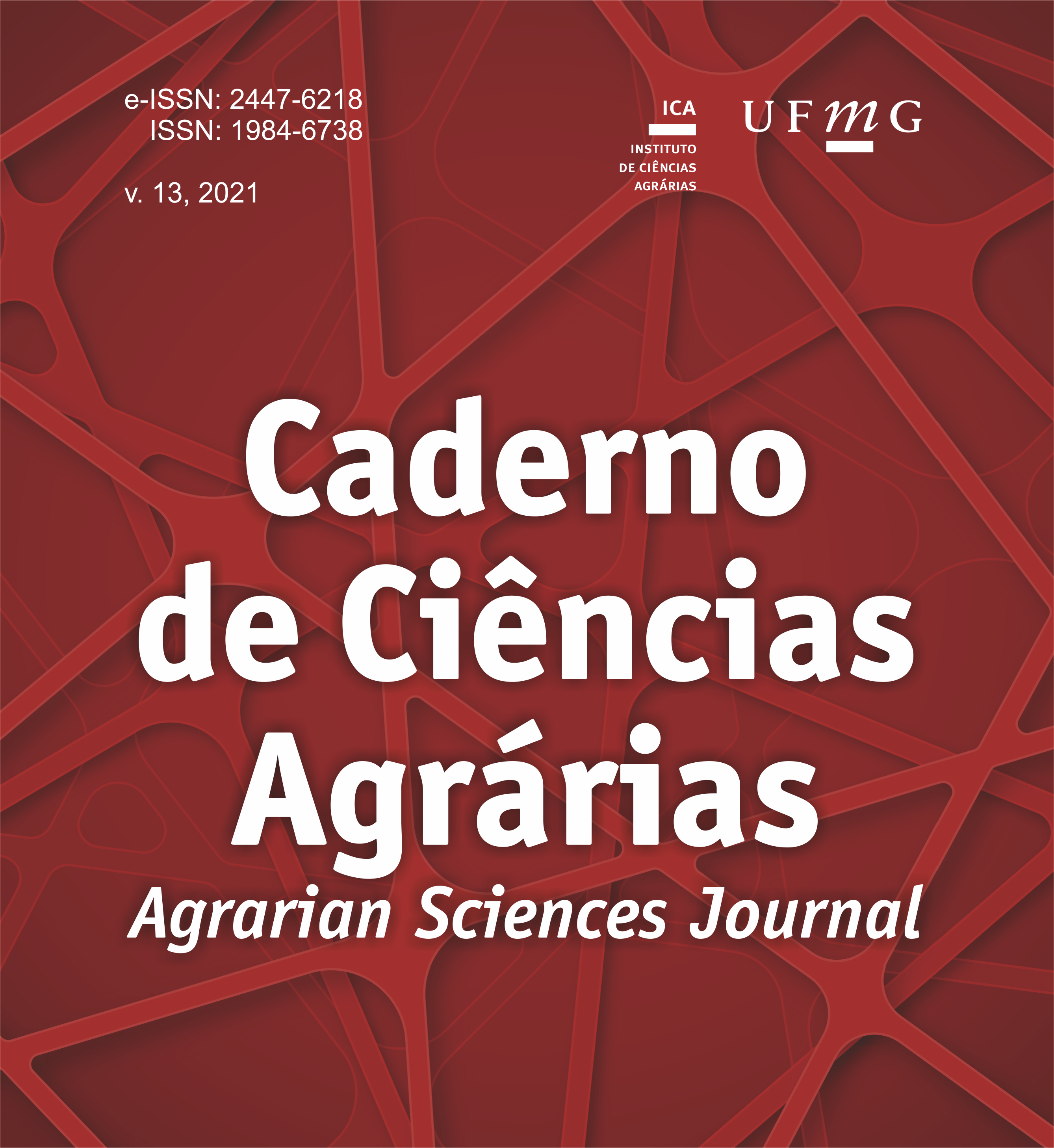Diversity of the psyllids and their host plants (Hemiptera, Psylloidea) from the Parque Estadual Caminho dos Gerais and surroundings, MG, Brazil
DOI:
https://doi.org/10.35699/2447-6218.2021.34280Keywords:
Endemics, Jumping plant lice, New state records, Rock vegetationAbstract
The psyllid fauna of the Parque Estadual Caminho dos Gerais and its surroundings is described based on a recent survey. Twenty three species are recorded from the municipalities of Gameleiras, Mamonas, and Monte Azul from where no previous records are known. Ten of the species are described, three are provisionally referred to described species due to insufficient material and ten constitute undescribed taxa. Each a species is reported for the first time for the states of Mato Grosso do Sul and Minas Gerais respectively. Almost half of the species are widely distributed, but two species appear to be endemic to the region. Fifteen species are associated with Fabaceae, a pattern that reflects a general pattern in Psylloidea.
Downloads
References
Barreto, M.; Queiroz, D. L.; Burckhardt, D.; Foerster, L. A. 2020. Checklist of jumping plant-lice (Hemiptera, Sternorrhyncha, Psyllidae) fromMato Grosso, Brazil. Ciência Florestal, 30, 3: 873–884. DOI: https://doi.org/10.5902/1980509840612.
Brown, R. G.; Hodkinson, I. D. 1988. Taxonomy and ecology of the jumping plant-lice of Panama (Homoptera: Psylloidea). E. J. Brill, Scandinavian Science Press Ltd., Leiden.
Burckhardt, D. 1987. Jumping plant lice (Homoptera: Psylloidea) of the temperate neotropical region. Part 2: Psyllidae (subfamilies Diaphorininae, Acizziinae, Ciriacreminae and Psyllinae). Zoological Journal of the Linnean Society, 90: 145–205. DOI: https://doi.org/10.1111/j.1096-3642.1987.tb01353.x.
Burckhardt, D. 1988. Jumping plant lice (Homoptera: Psylloidea) of the temperate neotropical region. Part 3: Calophyidae and Triozidae.Zoological Journal of the Linnean Society, 92: 115–191. DOI: https://doi.org/10.1111/j.1096-3642.1988.tb00101.x.
Burckhardt, D. 1994. Psylloid pests of temperate and subtropical cropand ornamental plants (Hemiptera, Psylloidea): a review. Trends in Agricultural Sciences, Entomology, 2: 173–186.
Burckhardt, D. 2021. Queiroziella gen. nov., a new genus of jumping plant-lice (Hemiptera, Psyllidae) from Southern Brazil associated with Mimosa scabrella (Leguminosae). Zootaxa 4927, 3: 359–382. DOI: https://doi.org/10.11646/zootaxa.4927.3.3.
Burckhardt, D.; Basset Y. 2000. The jumping plant-lice (Hemiptera, Psylloidea) associated with Schinus (Anacardiaceae): systematics, biogeography and host plant relationships. Journal of Natural History,34: 57–155. DOI: https://doi.org/10.1080/002229300299688.
Burckhardt, D.; Ouvrard, D.; Percy, D. M. 2021. An updated classification of the jumping plant-lice (Hemiptera: Psylloidea) based on molecular and morphological evidence. European Journal of Taxonomy, 736:137–182. DOI: https://doi.org/10.5852/ejt.2021.736.1257.
Burckhardt, D.; Ouvrard, D.; Queiroz, D.; Percy, D. 2014. Psyllid host-plants (Hemiptera: Psylloidea): resolving a semantic problem. Florida Entomologist 97, 1: 242–246. DOI: https://doi.org/10.1653/024.097.0132.
Burckhardt, D.; Queiroz D. L. 2012. Commented checklist of the jumping plant-lice (Hemiptera: Psylloidea) from Brazil. Zootaxa, 3571: 26–48. DOI: https://doi.org/10.11646/zootaxa.3571.1.2.
Burckhardt, D.; Queiroz, D. L. 2020. Neotropical jumping plant-lice (Hemiptera, Psylloidea) associated with plants of the tribe Detarieae (Leguminosae, Detarioideae). Zootaxa 4733, 1: 1–73. DOI: https://doi.org/10.11646/zootaxa.4733.1.1.
Burckhardt, D.; Queiroz, D. L. 2021. Psylloidea. In: Catálogo Taxonômico da Fauna do Brasil. PNUD. Available from: http://fauna.jbrj.gov.br/fauna/faunadobrasil/97523.
Crawford, D. L. 1914. A monograph of the jumping plant-lice or Psyllidae of the New World. Government Printing Office, Washington, IX + 186 pp. DOI: https://doi.org/10.5479/si.03629236.85.1.
Flora do Brasil. 2021. Available at: <http://floradobrasil.jbrj.gov.br/
reflora/listaBrasil/PrincipalUC/PrincipalUC.do#CondicaoTaxonCP>.
Hollis, D. 2004. Australian Psylloidea: Jumping plantlice and lerp insects. Department of the Environment and Heritage, Canberra, 216 pp.
Hodkinson, I. D. 2009. Life cycle variation and adaptation injumping plant lice (Insecta:Hemiptera: Psylloidea): a globalsynthesis. Journal of Natural History, 43: 65–179. DOI: https://doi.org/10.1080/00222930802354167.
Machado, L. M.; Burckhardt, D.; Queiroz, D. L.; Costa, E. C.; Machado, D.do N.; Pedron, L. 2017. First record of Heteropsylla caldwelli Burckhardt(Hemiptera: Psyllidae) from Brazil and its population dynamics onearpod tree in Rio Grande do Sul. Revista de Entomología, 61: 290–293.DOI: https://doi.org/10.1016/j.rbe.2017.07.003.
Meioambiente.MG. 2007. Parque Estadual Caminho dos Gerais. http://www.ief.mg.gov.br/unidades-de-conservacao/248.
Marsaro, A. L. Jr; Burckhardt, D.; Queiroz, D. L. 2021. Checklist e novos registros de Psylloidea (Insecta: Hemiptera) para o Rio Grande do Sul,Brasil. Revista Científica Intelletto, 6,1: 7–21.
Mendez, P.; Burckhardt, D.; Equihua-Martínez, A.; Valdez, J.; Estrada-Venegas E. G. 2016. Jumping plant lice of the genus Calophya (Hemiptera: Calophyidae) in Mexico. Florida Entomologist 99, 3: 417–425. DOI: https://doi.org/10.1653/024.099.0312.
Muddiman, S.B.; Hodkinson, I.D.; Hollis, D. 1992. Legume feeding psyllids of the genus Heteropsylla (Homoptera: Psylloidea). Bulletin of Entomological Research, 82: 73–117. DOI: https://doi.org/10.1017/S0007485300051518.
Oliveira, D.; Burckhardt, D.; Calácio, T.; Kuster, V.; Queiroz, D. 2019. Ceropsylla pouteriae Burckhardt sp. nov. (Hemiptera: Psylloidea: Triozidae), a new species of jumping plant-louse inducing galls on the leaves of Pouteria ramiflora (Mart.) Radlk. (Sapotaceae): taxonomy, gall structure and histochemistry. Journal of Natural History 53, 31–32:1923–1950. DOI: https://doi.org/10.1080/00222933.2019.1676931.
Ouvrard, D.; Chalise, P.; Percy, D. M. 2015. Host-plant leaps versus host-plant shuffle: a global survey reveals contrasting patterns in na oligophagous insect group (Hemiptera, Psylloidea). Systematics and Biodiversity, 2015: 1–21. DOI: https://doi.org/10.1080/14772000.2015.1046969.
Ouvrard, D. 2021. Psyl’list – The World Psylloidea Database. Available from: https://www.hemiptera-databases.org/psyllist/?&lang=en.
Queiroz, D. L.; Burckhardt, D.; Garrastazu, M. C. 2017. Protocolode coleta e montagem de psilídeos. Comunicado Técnico, Embrapa Florestas, 393: 1–11. https://www.infoteca.cnptia.embrapa.br/infoteca/bitstream/doc/1067827/1/CT39313pdf.
Rendón-Mera, D. I.; Burckhardt, D., Queiroz, D. L.; Cavichioli R. R. 2020. Taxonomy and host-plant relationships of the psyllid genus Mitrapsylla (Hemiptera: Psylloidea: Psyllidae) in Brazil. Zootaxa, 4887, 1: 1–100.DOI: https://doi.org/10.11646/zootaxa.4887.1.1.
White, I. M.; Hodkinson, I. D. 1985. Nymphal taxonomy and systematics of Psylloidea (Homoptera). Bulletin of the British Museum (NaturalHistory), Entomology Series, 50: 153–301.
Published
How to Cite
Issue
Section
License
Copyright (c) 2021 Agrarian Sciences Journal

This work is licensed under a Creative Commons Attribution-NonCommercial-NoDerivatives 4.0 International License.
Authors who publish in this journal agree to the following terms:
The Copyright for articles published in this journal follow authorship. The articles are open access, with their own attributions, in educational and non-commercial applications.
The journal reserves the right to make regulatory, orthographic and grammatical changes in the originals, with the aim of maintaining the standard language and the credibility of the vehicle. It will respect, however, the writing style of the authors.
Changes, corrections or suggestions of conceptual order will be forwarded to the authors, when necessary. In such cases, the articles, once appropriate, should be submitted for further consideration.
The opinions issued by the authors of the articles are their sole responsibility.







